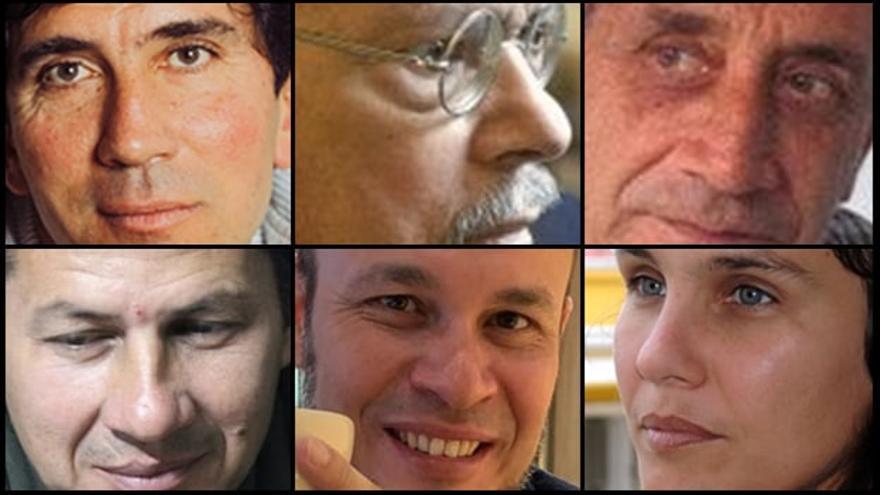
![]() 14ymedio, Xavier Carbonell, Salamanca, 21 May 2022 — Holguín exists thanks to a plague of ants and bibijaguas [leaf cutter ants]. It is the strangest and most enigmatic region of the Island. Columbus entered Cuba through it and in Nipe – the largest bay in the archipelago – the Virgin of Charity was found. In that province, according to Cabrera Infante, a dangerous “Bermuda triangle” was formed: Banes, Birán and Gibara. Batista was from Banes, Birán was the Galician fief from which the Castro brothers would emerge, and the writer himself was born in Gibara.
14ymedio, Xavier Carbonell, Salamanca, 21 May 2022 — Holguín exists thanks to a plague of ants and bibijaguas [leaf cutter ants]. It is the strangest and most enigmatic region of the Island. Columbus entered Cuba through it and in Nipe – the largest bay in the archipelago – the Virgin of Charity was found. In that province, according to Cabrera Infante, a dangerous “Bermuda triangle” was formed: Banes, Birán and Gibara. Batista was from Banes, Birán was the Galician fief from which the Castro brothers would emerge, and the writer himself was born in Gibara.
To that list of people from Holguin – both brilliant and disastrous – should be added General Calixto García, the pianist Frank Fernández, the great poet Gastón Baquero, Arnaldo Ochoa – the most famous person executed by the revolution – and even the current Prime Minister, Manuel Marrero Cruz.
Holguín, with its warmth and mystery, is also the city of “rebel” poets, the uncomfortable, imprisoned and exiled ones par excellence, such as Reinaldo Arenas and Delfín Prats. Both have gone down in history for their dissident vocation and because they did not remain silent in the face of power. The two were marginalized and deprived – in their time – of the place that corresponded to them in national literature.
Arenas – the best Cuban novelist after Carpentier – opened up the possibilities of a nonconformist and harsh voice, which embodied all marginalizations: homosexuality, “illiteracy” according to the parameters of its censors, drama, the drive towards death, and its eastern and guajira origin. Like a protective ghost of his own, the example of Arenas returned to his land and was fruitful.
Offering a testimony of that dissident tradition of Holguin writing is Esa secreta sinfonía [That secret symphony]. More than 30 “heir” poets are grouped around a common and imaginary space: the intimate homeland, the city of the Cruz and the parks, and the lands and towns that surround it.
The anthology, with a selection by Beatriz Torrente and edited by Orlando Coré, reviews the most significant authors of the province, whose generations are clearly outlined: the first, inaugurated by Arenas himself, involves already classic and renowned poets, such as Delfín Prats, who lived their youth at the beginning of Castroism.
The second is that of the “sons of the revolution” – such as Ghabriel Pérez, Rafael Vilches or Luis Yussef – who see the Berlin Wall fall and write during the Special Period, with blackouts and shortages.
And the third is that of those who are now 30 or 40 years old, born of disappointment, and many of them exiled or about to be: Moisés Mayán, Javier L. Mora, Camilo Noa, Yunior García Aguilera and Jamila Medina, perhaps the voice most important of this time.
Beyond the usual themes – time, sexuality, death, passions – they all share a meditation on History that often turns into anxiety: “Hemlocks, gallows, crucifixions, bonfires, exiles, castrations, executions and torture, and you impassive,” claims Arenas in the poem that opens the book.
But even when the denunciation, the prophecy, is demanded of him, the poet remembers that they are watching him and they will come looking for him, without anyone defending him: “How to speak of smells and times – of another terror – / when there on the corner / perennially a patrol car pulls up.”
Other poets, such as Orlando Coré, transform personal memory into writing, and offer evidence of their youth in the capital: “From the University of Havana they expelled / birds and diversionists. / Furtively, the / some recognized each other; / surreptitiously , the others, / passed the proscribed titles: / we conspired.”
The motif of the Great Journey, the Journey of Initiation – from east to west, from “the hill” to “the plain” – is frequent in provincial writers, but the generations after Arenas and Coré seek their horizon in exile.
Holguín, like Cuba, is scattered around the globe. As Yunior García notes: “We are not an island, damn it / We are an archipelago / One that holds on with brittle threads / Its unconnected parts / One that has already lost islets at night / And keys in the fog.”
The anthologists place between the pages of That secret symphony an old map of Holguín. In this symbolic space, poets, living and dead, exiled or insular, gather to share their painful memory. This book not only fulfills the role of a poetic collection, but also represents the spirit of that yellowish map of the city: a compass with which to find the deep, lucid and anguished voice of Holguin, which is also Cuban.
____________
Editor’s Note: That secret symphony. Cuban poets from Holguín, selection by Beatriz Torrente and edition by Orlando Coré, Loma de la Cruz Ediciones. Holguín-Miami, 2022, 312 pages.
____________
COLLABORATE WITH OUR WORK: The 14ymedio team is committed to practicing serious journalism that reflects Cuba’s reality in all its depth. Thank you for joining us on this long journey. We invite you to continue supporting us by becoming a member of 14ymedio now. Together we can continue transforming journalism in Cuba.
